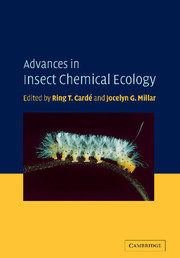Book contents
- Frontmatter
- Contents
- List of contributors
- Preface
- 1 Phytochemical diversity of insect defenses in tropical and temperate plant families
- 2 Recruitment of predators and parasitoids by herbivore-injured plants
- 3 Chemical ecology of astigmatid mites
- 4 Semiochemistry of spiders
- 5 Why do flowers smell? The chemical ecology of fragrance-driven pollination
- 6 Sex pheromones of cockroaches
- 7 A quest for alkaloids: the curious relationship between tiger moths and plants containing pyrrolizidine alkaloids
- 8 Structure of the pheromone communication channel in moths
- Index
- References
1 - Phytochemical diversity of insect defenses in tropical and temperate plant families
Published online by Cambridge University Press: 07 August 2009
- Frontmatter
- Contents
- List of contributors
- Preface
- 1 Phytochemical diversity of insect defenses in tropical and temperate plant families
- 2 Recruitment of predators and parasitoids by herbivore-injured plants
- 3 Chemical ecology of astigmatid mites
- 4 Semiochemistry of spiders
- 5 Why do flowers smell? The chemical ecology of fragrance-driven pollination
- 6 Sex pheromones of cockroaches
- 7 A quest for alkaloids: the curious relationship between tiger moths and plants containing pyrrolizidine alkaloids
- 8 Structure of the pheromone communication channel in moths
- Index
- References
Summary
Phytochemical diversity and redundancy
One of the most intriguing features of the chemical ecology of plant–insect interactions is the remarkable number of different phytochemical defenses found in plants. A single plant may contain five or six biosynthetic groups of secondary metabolites and within each group these defenses may include many structurally related analogs and derivatives. Across the different species of higher plants, there is a bewildering array of different substances and modes of actions of substances. During the course of our research on phytochemical defenses in specific plant families, we have become interested in the raison d'être for this diversity, as have many other researchers (Romeo et al., 1996). How much do we know about different types of defenses in plants? How did they arise? Are some of these secondary metabolites “redundant,” with no function? How do they interact with one another? In this chapter, we will address some of these issues with observations on the defenses of several plant families against insects, using results from our own research and the published literature.
In general, we do not have a comprehensive picture of the different types of defenses in plants. Over a decade ago, Soejarto and Farnsworth (1989) estimated that of the 250 000 species of flowering plants, only 5000 species had been thoroughly investigated according to the Natural Product Alert (NAPRALERT) database, leaving 98% of species with potential for phytochemical discovery.
- Type
- Chapter
- Information
- Advances in Insect Chemical Ecology , pp. 1 - 20Publisher: Cambridge University PressPrint publication year: 2004
References
- 6
- Cited by



